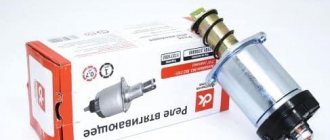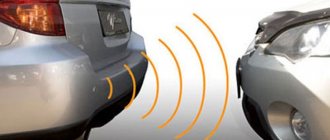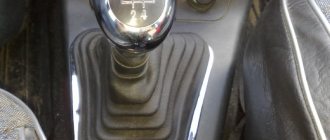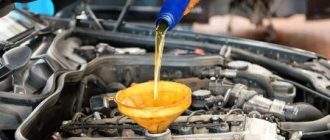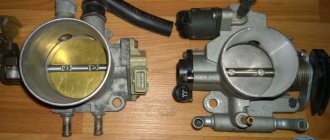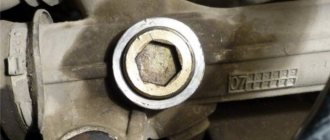VAZ 2106 fuse box pinout, diagram
If you have any problems with electrical equipment: the low or high beams have disappeared or are not working, the turn signals, stove, cigarette lighter, fan, wipers are not working, the signal has disappeared, etc., then this could all be the reason that the fuse has blown. This means it needs to be replaced.
To do this, you need to know the location of the mounting block. And it is located under the steering wheel, on the left side. In order to understand what the VAZ 2106 fuses are responsible for, you need to look at the simple pinout of the old fuse block (FB) and see the description below.
Table “VAZ 2106 fuse designations”
| Fuse number | Current, A | What is he responsible for? |
| 1 | 16 | 1. Lamps 2. Horns 3. Power socket 4. Cigarette lighter 5. Rear lamps 6. Front door open warning lamps 7. Clock |
| 2 | 8 | 1. Windshield wiper and wiper relay 2. Wiper motor 3. Heater motor |
| 3 | 8 | Left headlight (high beam) and high beam indicator lamp |
| 4 | 8 | Right headlight (high beam) |
| 5 | 8 | Left headlight (low beam) |
| 6 | 8 | Right headlight (low beam) |
| 7 | 8 | 1. Left front marker 2. Right rear marker 3. Trunk light 4. License plate light 5. Instrument lights 6. Cigarette lighter light |
| 8 | 8 | 1. Right front marker 2. Left rear marker 3. License plate light 4. Engine compartment lamp 5. Side light indicator lamp |
| 9 | 8 | 1. Oil pressure sensor with warning lamp 2. Coolant temperature sensor 3. Fuel level with reserve warning lamp 4. Parking brake activation and brake fluid level warning lamps 5. Turn signals and corresponding warning lamps 6. Battery charge warning lamp 7. Control lamp carburetor choke control lamp 8. Carburetor shut-off valve 9. Tachometer 10. Reversing lamps 11. Glove compartment lamp 12. Rear window heating relay coil |
| 10 | 8 | 1. Voltage regulator. 2. Generator excitation winding |
| 11 | 8 | Spare |
| 12 | 8 | Spare |
| 13 | 8 | Spare |
| 14 | 16 | Heated rear window |
| 15 | 16 | Engine cooling fan |
| 16 | 8 | "Emergency" |
Types of fuses
A competent choice of fuses will save VAZ-2106 owners from serious problems. Incorrectly selected parts can cause problems such as vehicle fires. When choosing these parts, you should pay attention to the current strength in them, which is expressed in Amperes. Fuses of different amperages have corresponding digital markings and also differ from each other in color. For example, brown ones have a rating of seven and a half Amperes, blue ones - 16A, green ones - 20A. It is important that the ratings of each part coincide with the manufacturers' recommendations.
Relay VAZ 2106
The following shows the location and designation of each factory relay:
- Voltage regulator, which is responsible for proper charging of the battery. Located on the left mudguard.
Battery charge voltage regulator relay - Turning on the radiator cooling fan. It is also located on the left mudguard, behind the expansion tank.
Radiator fan relay - A light on the dashboard that indicates battery charging. The relay is already located on the right mudguard.
Battery charging light relay - Low and high beam headlights. They are also located on the right mudguard. They are identical and interchangeable.
Relay for low and high beam headlights - Turn and hazard warning relay. It is located behind the instrument panel, approximately behind the tachometer.
- The wiper relay is located on the left side, under the instrument panel.
The video below clearly shows where which relay is located.
Location and electrical diagram
The power supply itself consists of two lines with fuses, which is installed in the car interior and attached to the body with two nuts. In particular, it is located on the driver's side under the instrument panel. Below is a diagram of the device, as well as the purpose of each element.
Diagram of an old-style block installed in a VAZ 2106 car
Description and purpose of each fuse block of the VAZ 2106 car
As you can see, almost all circuits of a domestically produced car are protected using fusible devices. However, there are exceptions here too. In particular, we are talking about:
- starter retractor relay - it is missing;
- the power circuit of the relay coil, which ensures the operation of the radiator fan of the cooling system, is also not protected;
- the ignition coil is also not protected by a relay;
- If your car has an old-style power supply, then it does not have a power supply circuit for the switch and a Hall sensor.
The element installed in the power supply is designed for a certain voltage in the wiring. This voltage is calculated using a simple formula - the voltage of all energy consumers in the wire must be multiplied by the reserve number, ranging from 1.2 to 1.5. So what's the purpose? In order for the operation to be stable, the nominal values of the block elements must match.
Car VAZ 2106
It should be added that very often owners of 2106 make mistakes by using an ordinary coin instead of a fusible device. It is better not to do this, since a short circuit may occur in your car at any time. Therefore, old-style power supplies, like any other machine component, also require periodic maintenance. Due to design features, that is, weak power supply holders or tips that regularly oxidize, you may notice the contact part burning.
Thus, due to the increased contact resistance, overheating occurs and the contact condition of the element deteriorates. This may result in additional problems with the vehicle's wiring. To prevent this from happening, you should periodically, at least twice a year, inspect the power supply unit as a whole. Clean the mounting sockets, inspect the power supply and promptly replace failed fuses.
But this all applies to old-style power supplies. Some owners of these car models, taking into account the periodic problems with the old-style power supply, change it to a new one.
Power supply unit for a new VAZ 2106 car
"Euroblock" VAZ 2106 (new model), diagram
Below is a picture of what the Eurobloc looks like in real life.
Photo of Euro block VAZ 2106
Below is the pinout of the new type of power supply or, as people say, “Euroblock”. The diagram also shows which fuse is responsible for what.
VAZ 2106 fuse block diagram with decoding
Replacement
The fuses are secured with spring terminals. There are two types: black (8 amps) and green (16 amps).
The burned out element looks like this:
- Using a screwdriver, remove the cover.
- We press out one of the terminals, remove the burnt-out element and put a new one of the same rating in its place.
- We put the cover in place.
The replacement process is carried out in a similar way in the additional block.
Replacing the VAZ 2106 fuse box with a “Euroblock”
And finally, for those who don’t know how to replace the old model with a “Euroblock”, the following information. There is nothing complicated here.
You just need to follow the instructions below:
- First you need to disconnect the minus from the battery.
- Use a 10mm wrench to unscrew the old power supply. In this case, the wires are not disconnected.
- According to the diagram above, wires and jumpers are installed.
- It is important to install jumpers only on those wires that carry voltage from the engine compartment.
- Jumpers are installed between pins 3-4, 5-6, 7-8, 9-10, 11-12.
- Next, the wires are removed one by one from the old device and attached to the Euroblock.
- At the end, check that the connection is correct (for example, with the low beam on, if you pull out the 5th fuse, the left headlight should go out).
- All other circuits are also checked.
The video below clearly shows how to replace an old power supply with a Euroblock.
Repair and replacement of fuses
The fuse box diagram will help you determine what you need to purchase. Factory spare parts can be purchased in specialized stores that service and sell auto parts at VAZ. The repair scheme is as follows: initially, the cause of the breakdown is determined and it is determined what will be required: replacement of the element or the entire module.
When a fuse trips, you should not rush: the layout of the elements of the safety module will help you figure out which circuit protects this element. Later, you need to determine the cause of the short circuit and try to eliminate it. After repair, having insulated the wires, you can insert a new fuse.
replaced in this way.
| Actions | Nuances |
| Disconnect the battery. Open the driver's door slightly. | Using a screwdriver, lift the two fasteners that fasten the decorative interior upholstery. |
| After the module appears, use a Phillips screwdriver to unscrew its fasteners. | You need to watch the wires so that they do not fly out of the terminals. |
| After unscrewing the module, it is taken to the bottom. | This is done carefully so that the wiring does not break. |
| Jumpers are installed exclusively on wiring that supplies voltage from the engine compartment. | The jumper is not connected after the fuse, because then voltage will flow through one element to several parts of the equipment. |
| The jumper installation diagram is as follows. | 3 and 4, 5 and 6, 7 and 8, 9 and 10, 11 and 12, 12 and 13. |
| Then, one by one, remove the wire from the old module and mount it on the one being installed. | Do this with all wires. |
Scheme
The black box and relay are first checked and carefully inspected, and only then replaced with new ones. On the inside of the lid there is a diagram of the box that anyone can use.
- (power - 16A) - responsible for sound, front door alarm lights, lamps, cigarette lighter, clock;
- (power – 8A) – controls the relay, heater, windshield electric motor, windshield wipers;
- – controls the high-beam headlights on the left side and the indicator light;
- – controls the high beam headlights on the right;
- – responsible for the operation of the left low beam headlights;
- – controls the right low beam headlights;
- – responsible for the left front and right rear dimensions, and for the lighting of the rooms;
- – monitors the operation of the right front and left rear lights, as well as the engine compartment lighting and warning light;
- – responsible for rear traffic lights, turn signals, luggage compartment lighting, oil pressure indicator, brake light, tachometer;
- – controls the voltage regulator;
- – backup fuses (RP);
- – RP;
- – RP;
- – controls the operation of the rear window electric heating;
- – controls the operation of the fan and engine cooling;
- – is responsible for the operation of emergency mode indicators.
Flat fuses are installed on the euro fuse blocks on the VAZ-2106 (new type boxes). The first of them has a power of 16 A, all the others - 8A. The connection diagram for the VAZ 2106 euro fuse box is given below.
- – responsible for the sound signal, interior lighting, brake lights, clock and cigarette lighter;
- – windshield washer, heater motors, wiper relay;
- – high beam on the left and high beam indicator;
- – high beam on the right;
- – low beam on the left;
- – low beam on the right and rear fog lamp;
- – left front and right rear dimensions, luggage compartment lighting, license plate lighting, cigarette lighter lighting, instrument lighting;
- – right front and left rear dimensions, engine compartment lighting;
- – indicators for oil pressure, cooling fluid temperature, fuel level, rear heated glass, turn signals;
- – regulates the generator voltage;
- – reserve (R);
- - R;
- - R;
- – electric heated glass at the rear;
- - cooling system;
- - emergency mode.
The diagram of a regular VAZ 2106 fuse box and the diagram of the new model box are very similar. The difference is in the details themselves. A regular “black box” uses blade fuses, while the new type unit uses flag fuses.
Recommendations for use
- Replace a blown fuse only with one of the same rating. Otherwise, if a larger one is installed, the equipment will not be protected from possible voltage surges. If it is smaller, then it is likely that it will burn out immediately.
- Do not use jumpers or bugs under any circumstances. Their installation can lead to equipment failure and even a fire.
- If there are malfunctions in the operation of any consumer, then pay attention and diagnose the block itself with electrical fuses.
- While operating the vehicle, be sure to diagnose all elements of the on-board network. An important part of diagnostics is checking the integrity of all wiring.
- When working with sources and electrical consumers, you must always pay attention to safety precautions, otherwise you risk injury or damage.
- Before starting work, be sure to turn off the power to the system.
Sorry, there are no surveys available at this time.
Typical symptoms of a faulty fuse
- The fuse has changed color, pinholes are visible, the predominant color is black. A symptom characteristic of old-style modules. The new ones don’t have this, the design is different;
- An indicator on the dashboard indicates a malfunction of one or another equipment;
- The mechanisms are not active when the engine is running, the ignition is on, and the battery is working;
- A burning smell can be heard in the cabin, emanating from the place where the power supply unit is fixed;
- The modules feel hot to the touch, with an unnatural temperature.

